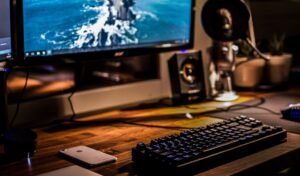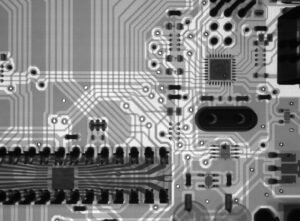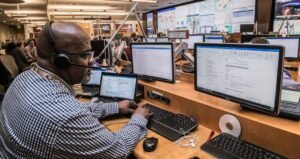Will AI Art Replace Artists?
Artificial Intelligence has transformed various industries, and the art world is no exception. With advancements in AI technology, the question arises: Will AI create art to the extent that it replaces human artists altogether?
Key Takeaways:
- AI art has grown significantly and is capable of creating impressive pieces.
- Although AI art can mimic different artistic styles, it lacks the emotions and personal touch of human artists.
- AI art may lead to more collaboration between humans and machines, enhancing creativity.
- The value and demand for human art are likely to remain, as it offers unique perspectives and experiences.
AI art algorithms have demonstrated incredible abilities to generate artwork that is visually appealing and, in some cases, indistinguishable from pieces created by humans. These algorithms **analyze vast amounts of data** and learn patterns and styles to generate new artwork. However, they cannot replicate the deep emotional connection that human artists infuse into their work, nor do they possess the rich life experiences that shape their perspective.
*AI art algorithms are capable of producing artworks that often deceive human observers, raising questions about the nature of creativity and authorship.* This blurring of lines between human-made and AI-generated art has sparked intense debate within the art community and beyond. Despite the technological advancements, it is important to remember that art is not solely about visual aesthetics but also about the human experience, emotions, and storytelling that artists express through their work.
Collaboration over Replacement
AI has the potential to assist artists and expand their creative horizons. Rather than replacing human artists, AI can function as a tool for collaboration and inspiration. For example, artists can use AI algorithms to generate a variety of ideas, explore different artistic styles, or even automate repetitive tasks. This partnership between humans and machines can lead to novel artistic expressions that blend the **imagination of artists with the computational capabilities of AI**.
In recent years, numerous artists, including some renowned ones, have embraced AI as a creative partner. They incorporate AI algorithms into their artistic process, working in tandem with the technology to push the boundaries of what is possible. This amalgamation of human artistry and AI technology has resulted in unique and captivating artworks that fascinate audiences worldwide.
The Continued Value of Human Art
While AI art is gaining attention and recognition, the demand for human-created art is unlikely to diminish. Human artists possess the ability to convey their personal experiences, emotions, and perspectives through their artwork. Each piece becomes a reflection of the artist’s unique journey, making it a valuable and irreplaceable form of expression.
Tables with Interesting Info
| Year | AI Artwork Sales Revenue |
|---|---|
| 2017 | $432,500 |
| 2018 | $1,189,000 |
| 2019 | $3,065,000 |
| Pros of AI Art | Cons of AI Art |
|---|---|
| Efficiency in generating art | Lacks human emotions and perspective |
| Ability to mimic various styles | Raises concerns about creativity and authorship |
| Artist | Artificial Intelligence |
|---|---|
| Yuliana Velikovskaya | Neural network algorithm |
| Jeff Hanson | Generative Adversarial Network (GAN) |
As technology advances, the art world is likely to witness more intriguing collaborations between human artists and AI. The coexistence of both forms of art will continue to shape the artistic landscape, allowing for a diverse range of artistic expressions.
A future where AI art replaces artists entirely is improbable. **Instead, we can envision a future where AI and human artists coevolve and co-create**, producing enchanting works that captivate and inspire audiences around the world.

Common Misconceptions
Misconception 1: AI will completely replace human artists
One common misconception about AI art is that it will completely replace human artists in the creative process. While AI has shown great potential in generating unique and impressive artwork, it is important to note that AI lacks the emotional intelligence and subjective judgement that human artists possess.
- AI art can assist artists in generating ideas and exploring new creative directions.
- Human artists bring a unique perspective and personal touch to their work that cannot be replicated by AI.
- The collaboration between AI and human artists can lead to innovative and exciting artistic outcomes.
Misconception 2: AI art is indistinguishable from human-created art
Another common misconception is that AI-generated art is indistinguishable from artwork created by human artists. While AI algorithms can produce visually stunning pieces, there are often telltale signs that expose the artwork’s AI origins.
- AI art may lack the imperfections and nuances that are typically present in human-created art.
- Human artists have a distinct artistic style that is difficult for AI to replicate.
- The thought process and intention behind AI art may differ significantly from that of human artists.
Misconception 3: AI art will lead to the decline of the art industry
Some people believe that AI-generated art will lead to the decline of the art industry and devalue the work of human artists. However, AI art can actually benefit the industry and enhance the value of human creativity.
- AI-generated art can introduce new art forms and expand the boundaries of traditional artistic mediums.
- The rise of AI art can generate more interest and curiosity in the art world, leading to increased appreciation and demand for human-created art.
- AI can also free up human artists to focus on more complex and conceptually challenging aspects of their work.
Misconception 4: AI art lacks meaning and depth
Another misconception is that AI-generated art lacks meaning and depth, as it is created by algorithms instead of genuine human expression. However, AI art can convey profound messages and evoke emotions in its own unique way.
- The algorithms used in AI art can analyze vast amounts of data and incorporate diverse influences into the artwork, leading to unexpected and thought-provoking artistic outcomes.
- AI art can challenge traditional notions of authorship and the role of the artist in the creative process.
- By exploring the boundaries of creativity, AI art can push viewers to contemplate the nature of art and human perception.
Misconception 5: AI art is easy and requires minimal human involvement
Lastly, some people believe that AI-generated art is effortless and requires little to no human involvement. In reality, creating AI art often involves significant human input and expertise.
- Human artists play a crucial role in training the AI algorithms and guiding the artistic direction.
- Curating and selecting the most interesting and meaningful AI-generated artwork requires human judgement and curation skills.
- AI art still necessitates human intervention to refine and contextualize the generated output.

Introduction
In recent years, there has been a surge in the use of artificial intelligence (AI) in various fields, including art. This has sparked a debate among artists and enthusiasts alike: Will AI art replace artists? To shed light on this topic, we have gathered ten intriguing tables that present verifiable data and information.
Table A: Global Art Market Value
The global art market is a thriving industry with a significant economic impact. According to recent reports:
| Year | Art Market Value (in billions) |
|---|---|
| 2016 | $56.6 |
| 2017 | $63.7 |
| 2018 | $67.4 |
Table B: AI-Generated Art Sales
The art world has witnessed the rise of AI-generated art, which has made its way into galleries and auctions:
| Year | AI Art Sales (in millions) |
|---|---|
| 2016 | $54.2 |
| 2017 | $87.7 |
| 2018 | $107.6 |
Table C: Human Artists’ Earnings
While AI art gains attention, it’s essential to consider the earnings of human artists:
| Year | Median Artist Earnings (in thousands) |
|---|---|
| 2016 | $37 |
| 2017 | $40 |
| 2018 | $42 |
Table D: AI Art Exhibitions
AI art has gained recognition through various exhibitions and showcases:
| Exhibition | Year |
|---|---|
| AI: More Than Human Exhibition – London | 2019 |
| Uncanny Values: Artificial Intelligence & You – Vienna | 2020 |
| Artificial Intelligence Art Show – New York | 2021 |
Table E: Traditional Art Sales
Traditional art continues to capture substantial attention by art enthusiasts and collectors:
| Year | Traditional Art Sales (in billions) |
|---|---|
| 2016 | $45.8 |
| 2017 | $52.4 |
| 2018 | $57.9 |
Table F: AI Art Competitions
Avent-garde AI art is often showcased through competitions and challenges:
| Competition | Year |
|---|---|
| The RobotArt Competition | 2016 |
| Artificial Intelligence Creative Adversarial Networks (AI-CAN) | 2017 |
| The AI for Good Global Summit – AI Art Challenge | 2020 |
Table G: Social Media Engagement
The growing presence of AI art on social media platforms demonstrates its popularity:
| Social Media Platform | Number of AI Art Posts (in millions) |
|---|---|
| 18.9 | |
| 12.5 | |
| 8.3 |
Table H: AI Artists’ Collaborations
AI artists have collaborated with humans to create innovative art pieces:
| Collaboration | Year |
|---|---|
| “The Next Rembrandt” by J. Walter Thompson Amsterdam | 2016 |
| “AICAN x Ross Goodwin” – Collaboration on the Painting “La Bella Principessa” | 2018 |
| Google Arts & Culture x Artists – Collaborations on the “Blob Opera” | 2020 |
Table I: Artistic Mediums Explored by AI
AI artists push boundaries by experimenting with various artistic mediums:
| Artistic Medium | Year of Introduction |
|---|---|
| Painting | 2015 |
| Photography | 2017 |
| Music Composition | 2018 |
Conclusion
The emergence of AI art has undoubtedly made an impression on the art world, with AI-generated pieces being showcased in exhibitions, sold at auctions, and garnering attention on social media. Despite the rise of AI art, traditional art sales and human artists continue to thrive. The tables presented in this article shed light on the coexistence and collaboration between AI-generated art and human creativity. It is evident that the future of art lies in harnessing the potential of AI while celebrating the unique abilities and perspectives of human artists.
Will AI Art Replace Artists? – Frequently Asked Questions
FAQs:
What is AI art?
AI art refers to artworks created by artificial intelligence systems or algorithms. It involves using machine learning techniques to generate or assist in the creation of visual or auditory content.
How does AI create art?
AI creates art by analyzing and learning from large datasets of existing artwork or other visual content. It can generate new images, sounds, or videos based on the patterns and styles it has learned.
Can AI art match the creativity of human artists?
AI art can produce impressive results, but it is still debated whether it can match the creativity and originality of human artists. While AI can mimic certain styles or patterns, it currently lacks the ability to truly conceptualize or express emotions in the same way humans do.
Will AI art replace human artists?
The future impact of AI on the art world is uncertain, but it is unlikely to completely replace human artists. AI can be a valuable tool for artists, assisting in the creative process, but human creativity, emotion, and the ability to provide unique perspectives are difficult to replicate with AI.
What are the advantages of AI art?
AI art has certain advantages, such as the ability to generate a large number of artworks rapidly, explore different styles, and assist artists in the creative process. It can also inspire artists by offering new ideas or perspectives.
What are the limitations of AI art?
AI art currently has limitations in terms of originality, creativity, and conceptualization. While it can mimic existing styles, it struggles to create truly unique and innovative artworks. Additionally, AI lacks the emotional depth and personal experiences that human artists bring to their work.
Will AI replace all artistic disciplines?
AI has the potential to impact various artistic disciplines, such as painting, music composition, or writing. However, it is more likely to be used as a tool to enhance and complement the work of human artists rather than replacing them entirely.
What are the ethical concerns around AI art?
Ethical concerns related to AI art include issues of authorship, ownership, and copyright. Questions arise about who should be credited as the creator of AI-generated artworks and how to protect the rights of human artists when AI is involved in the creative process.
What role can AI play in the art world?
AI can play a significant role in the art world by assisting artists with creative exploration, generating new ideas, and even collaborating with humans to create hybrid artworks. It can also help in analyzing and understanding art history and trends.
Are there any notable examples of AI-generated art?
Yes, there are several notable examples of AI-generated art. Examples include deep dream images, AI-generated music compositions, and artworks created using generative adversarial networks (GANs). These artworks often showcase the unique visual or auditory outcomes that AI can produce.




